Frankston City. Our next chapter.





Welcome to Frankston City
Acknowledgement
Frankston City Council acknowledges the Bunurong people of the Kulin Nation as the Traditional Custodians of the lands and waters in and around Frankston City, and value and recognise local Aboriginal and Torres Strait Islander cultures, heritage and connection to land as a proud part of a shared identity for Frankston City.
Council pays respect to Elders past and present and recognises their importance in maintaining knowledge, traditions and culture in our community.
Council also respectfully acknowledges the Bunurong Land Council as the Registered Aboriginal Party responsible for managing the Aboriginal cultural heritage of the land and waters where Frankston City Council is situated.


I am delightedto present Frankston City Council’s proposed2021-2031 Financial Plan, which demonstrates how Council will continue to responsibly deliver community services and infrastructure while maintaining a sound financial position over the next decade.
Council’s focus is on delivering services, maintaining assets and investing in new infrastructure that will support our growing population while cementing Frankston City as the Lifestyle Capital of Victoria and moving towards achieving our 2040 Vision as being the place on the Bay to learn, live, work and play in a vibrant and socially supportive community.
Council has again successfully risen to the challenge of preparing a sound ten year Financial Plan that is capable of withstanding the Victorian Government’s imposed rate cap, which will undoubtedly continue to restrict Council’s income, risking our ability to deliver the vital services and infrastructure our community needs.
While this is a long-term Financial Plan that spans a decade, Council is also aware of the potential serious immediate and possible long-term impacts of the COVID-19 pandemic on the Plan.
As a Council, we have responded quickly to the changing needs of the community with our Relief and Recovery Package (part of the 2020–2021 Annual Budget), which includes a $3.86 million investment in vital community supports – taking the total to $9.128 million in ongoing assistance for our community.
Council is committed to delivering the best for our community, with an exciting $575 million Capital Works program planned over the ten years. This is complemented by a significant $293 million investment into maintain and expand existing infrastructure and to safeguard its future use.
Council has also invested in transforming the way we deliver our services to the community with our Future Ready Frankston Program. We have also worked hard to find savings and keep costs down without compromising on the quality of the services that Council delivers.
Council will continue to passionately advocate to Victorian and Federal Governments alongside our community for funding towards projects that continue this transformation into the perfect place to live, learn, work, invest and enjoy.
I encourage you to read this document and provide feedback on how we can continue to shape the future of Frankston City as a liveable, innovative and proud community and work towards achieving our shared vision.
Kris Bolam MayorThis proposed 2021-2031 Financial Plan has been prepared after significant consultation with the community, elected Members and Council staff.
It focuses on ensuring that Council continues to invest in core infrastructure, deliver key services and reinforce the City of Frankston’s resilience to future challenges.
It has also been designed to align with six key areas, promoting healthy and safe communities, community strength, a sustainable environment, a well-planned and liveable city, a thriving economy and a progressive and engaged city that you, our community told us were of value and importance to you.
Our journey in developing this document began with an unprecedented community consultation that ran throughout 2020 and early 2021, and included the creation of our first-ever Community Panel.
This panel was independently selected to represent the diverse needs of our community and developed the Community Vision Frankston 2040.
Councillors and Council officers’ workshopped current and future challenges for Frankston City and opportunities to create the municipality that our residents have told us they want to live in.
Covid-19 has had a major impact on the Council’s finances and like many households, we have to make savings to our day-to-day spending on operating and maintaining our services and infrastructure.
At the heart of Council’s decision making is the goal of promoting community wellbeing and transforming the way we deliver our services. Balancing our environmental goals and responsibilities with building a caring, welcoming and prosperous community often means making hard decisions.
We’ve considered what you’ve told us is important to you – delivering the basics and doing it better – and what we need to do to continue making progress.
This Financial Plan represents our best option for how we navigate the balance between meeting our City’s needs and maintaining a strong financial position.
If we try to spend more, we won’t be able to deliver on our ambitions, and will leave ourselves less financial headroom in the event of another unplanned event like the pandemic. If we try to spend less, the condition of our infrastructure assets and the
quality of the services we deliver would be at risk. We also need to play our role in stimulating the economic and social recovery after the pandemic.
Given there is no simple solution to address our current financial situation, we have looked at a selection of “levers’ available to us:
Focusing on what we can afford and actually delivering our capital works.
Finding permanent efficiencies in our day-to-day spending (what we call operational spending).
Borrowing for new projects that have a long term value, ensuring that the debt repayments are spread fairly across the generations of ratepayers who will benefit from them.
This plan includes targeted recurrent savings of $0.5 million each year, which equate to $32.6 million cumulative savings over ten years. These savings will be achieved mainly through our Future Ready Frankston Program which will ensure that we transform the way we deliver our services without compromising on the quality of the service.
The Future Ready Frankston Program will focus on four critical performance areas, culture, capability, connectivity and customer which will enable us to deliver better outcomes for our community.
Some of the initiatives we will be carrying out in the future include:
Continuing to engage with our community to understand the key services we deliver and the method of delivery;
Asset rationalisation and establishing target service levels;
Collaborative procurement initiatives and joint services;
Finding alternative revenue streams; and
Increased advocacy to fund existing projects.
You will find our proposed plan in the next few pages along with the financial strategies that we have that will enable us to deliver on what we are proposing.
Council wants to hear your feedback – what you think of our proposed plan. You can influence the decisions we make, and we want to hear from you. I strongly encourage you to have your say.
Phil Cantillon CEOThe Financial Plan defines the broad financial boundaries for Council over the next ten years.
The plan is broken up into three main sections:
Financial Policies that set out the financial targets that ensure Council remains financially sustainable
Financial Strategy identifies the approach Council intends to take to achieve the financial policies; and
Financial Statements apply the financial strategy to a ten year financial model to ensure Council meets their Financial Policy targets.

The Local Government Act 2020 (The Act) requires Councils to prepare a ten year Financial Plan in the year following a general election through the introduction of governance and supporting principles which include an integrated approach to planning, monitoring and performance reporting.
The Financial Plan is developed in the context of the following governance principles:
Council decisions are made and actions taken in accordance with the relevant law.
Priority is given to achieving the best outcomes for the municipal community, including future generations.
The economic, social and environmental sustainability of the municipal district, including mitigation and planning for climate change risks, is promoted.
The municipal community is engaged in strategic planning and strategic decision making.
Innovation and continuous improvement is pursued.
Collaboration with other Councils and Governments and statutory bodies is sought.
The ongoing financial viability of the Council is ensured.
Regional, state and national plans and policies are to be taken into account in strategic planning and decision making.
The transparency of Council decisions, actions and information is to be ensured.
In giving effect to the overarching governance principles, a Council must also take into account the following supporting principles:
The Financial Plan is developed in the context of the following strategic planning principles:
Council has an integrated approach to planning, monitoring and performance reporting.
Council Financial Plan addresses the Community Vision by funding the aspirations of the Council Plan. The Council Plan aspirations and actions are formulated in the context of the Community Vision.
The Financial Plan statements articulate the 10-year financial resources necessary to implement the goals and aspirations of the Council Plan to achieve the Community Vision.
Council's strategic planning principles identify and address the risks to effective implementation of the Financial Plan.
The Financial Plan provides for the strategic planning principles of ongoing monitoring of progress and reviews to identify and adapt to changing circumstances.
The Financial Plan demonstrates the following financial management principles:
Revenue, expenses, assets, liabilities, investments and financial transactions are managed in accordance with Council's financial policies and strategic plans.
Management of the following financial risks:
o Failure to adequately identify, plan and deliver services to the approved service standards that the community needs.
o Failure to plan for and manage Council's finances (Long Term Financial Sustainability).
Financial policies and strategic plans are designed to provide financial stability and predictability to the community.
Council maintains accounts and records that explain its financial operations and financial position.
The Financial Plan demonstrates the following service performance principles:
Services are provided in an equitable manner and are responsive to the diverse needs of the community.
The Council Plan is designed to identify the key services and projects to be delivered to the community. The Financial Plan provides the mechanism to demonstrate how the service aspirations within the Council Plan will be funded.
Services are accessible to the relevant users within the community.
Council provides quality services that provide value for money to the community. The Local Government Performance Reporting Framework (LGPRF) is designed to communicate council’s performance regarding the provision of quality and efficient services.
Council is developing a performance monitoring framework to continuously improve its service delivery standards.
Council is developing a service delivery framework that considers and responds to community feedback and complaints regarding service provision.
The Financial Plan demonstrates the following community engagement principles:
A community engagement with a clearly defined objective and scope.
Participants in community engagement have access to objective, relevant and timely information to inform their participation.
Participants in community engagement are representative of the persons and groups affected by the matter that is the subject of the community engagement.
Participants in community engagement we provided reasonable support to enable meaningful and informed engagement.
Participants in community engagement were informed of the ways in which the community engagement process will influence Council decision making.
Our Financial Plan provides clear direction on the allocation, management and use of financial resources. This is to keep our Council financially sustainable over the short, medium and long-term as we maintain services and assets, respond to growth and deliver on our strategic priorities, identifying steps to take now –for today – to remain financially sustainable into the next decade and beyond – for tomorrow, working towards our ideal community landscape.

Future-proofing our City today ….
• Increasing rates revenue at the rate cap and targeting the funds raised to those residents and businesses needing the most assistance in our community.
• Adjusting some services identified as a lower priority to enable a keener focus on core services.
• A service delivery framework developed with customer in mind.
• Investing in the Future Ready Frankston program which will focus on automating our processes with customer in mind, build our capability and enhance connectivity.
• Continuing to find efficiency savings on top of significant savings already delivered through a robust ‘bottom up’ budgeting process.
• Keeping fees and charges affordable, with those directly benefiting from or causing the expenditure making an appropriate contribution to the service, balanced by the capacity of people to pay.
• Prioritising capital expenditure utilising improved asset management practices when addressing essential infrastructure maintenance and renewal.
• Asset rationalisation and consolidation.
Means that tomorrow …
• Our Council continues to deliver the services that are needed by our community.
• Our Council continues to be a low-debt Council.
• Investment in technology has improved our services while producing further savings and benefits.
• Strategic investment in our public space, assets and infrastructure has supported growth.
• There are lower costs to ratepayers, as Council has addressed cost challenges rising above the rates cap.
• A continuing surplus remains to deal with the financial risks that are likely to occur and place additional fiscal stress on the City.
Financial Plan sets out to achieve long-term financial sustainability that resources the strategic plans working towards our ideal community landscape. Highlights from the Financial Statements are below:
Balanced financial position across the next ten years

Total Revenue less
Total Expenditure

Capital Works Expenditure plus Targeted Underlying Surplus

$575 million investment in capital works
$293 million investment in renewing and expanding assets
$150 million investment in upgrading existing assets
Including the following major projects:
$7 million
Bruce Park Pavilion


Estimated operational savings of $0.5 million per annum over ten years – 2021-2031
$23.5 million
Early years reform including Langwarrin and Seaford Early Learning Centres

$132 million investment in new assets
$25-28 million
Pines Pool Redevelopment

$25-30 million
Frankston Basketball & Regional Gymnastics Redevelopment

The Financial Plan achieves financial sustainability over the next ten years. However, our Council faces several strategic and financial risks that could impact short-term financial performance and financial sustainability over the longer-term.
These include:
“Failure to plan for and manage Council's finances (Long Term Financial Sustainability)”
The challenges for Council in achieving Long term financial sustainability will be addressed in this plan. The strategic actions and controls contained within this plan mitigate and reduce this risk.
While there are high levels of advantage and favourable health outcomes in Frankston, extreme disadvantage and poorer health outcomes exist in some neighbourhoods. The COVID-19 pandemic exacerbated this disadvantage and created challenges for others who up until that point had been doing relatively well.
Financial stress and job losses were significant over the last 12 months, with further economic impacts expected as Government support is reduced. The timeframe for economic recovery is unknown and the social, health and wellbeing impacts on our community will likely be felt well into the next decade.
“Failure to adequately identify, plan anddeliverservicestotheapproved service standards that the community needs”
The challenges for Council in identifying, planning and delivering services that the community needs will be addressed in this plan. The strategic actions and controls contained within this plan mitigate and reduce this risk.

Provide assistance to the community to recover from the impacts of COVID and the economic shock associated with responding to the pandemic and the impact on the local economy. Key issues requiring attention were:
• Mental health
• Community support
• Business support
• Investment attraction.
In the short term Council has invested $9.128m in recovery packages since the pandemic emerged. A $3.86M recovery package for 20212022 has been allocated to focus on reactivating the vibrancy of the municipality, local business support and support for those vulnerable members of the community. Medium to longer term Council has planned for adequate reserves to ensure we can respond to unexpected events.
The key challenge over the next decade will be keeping rates affordable by meeting the rate cap as pressure on other revenue sources combine with key service and construction costs grow quicker than the cap.
Council is confident that it can continue to manage the rates capping challenge in the 2021-2031 financial years. The challenge has been addressed through the identification of efficiency savings and a disciplined budget preparation process. The Financial Plan has been revised on the assumption that rates and charges will not increase by more than 2.00 per cent over the life of the plan.
To maintain financial sustainability in the face of the above challenge, Council also needs to fundamentally review its approach to service delivery. Council will need to assess what levels of services can be provided for a given maximum rate rise under rate capping. Some of the main outcomes from the Financial Plan is the quantification of the initiatives included in the council plan, cost of existing service requirements and the associated long term cash flow implications to maintain those service levels. This allows for the ongoing review of the affordability of existing service levels and their priority relative to emerging service demands and the capacity and willingness to pay of the community.

Response – Revenue and Rating Plan
Strategy in the Revenue and Rating Plan is to seek alternative sources of funding and reduce Council reliance on rates funding.
The Revenue and Rating Plan is a key informer to the Financial Plan and Budget.
Making the right decisions about capital investment and asset management is critical for Council to continue to meet its annual asset renewal targets as well as providing critical assets for service delivery to the Frankston Community.
The Community expects a strong focus on the future needs for this City and there are a number of key projects that need to be considered. Major capital works projects involves significant expenditure. Council must maintain its existing assets and meet the asset renewal challenges.

Response – Asset Strategy
Council aims to make the right decisions about capital investment and asset management through the delivery of their Asset Management Strategy and development of an Asset Plan (due 2022). These plans all feed into and inform the Long Term Infrastructure Plan and a core component of this Financial Plan.
The Asset Strategy statements in this plan identifies how we upgrade and maintain or rationalise our asset portfolio which is critical to service delivery, ensuring our assets are fit for purpose and used as efficiently as possible. Refer to page 18 Assets for more information on the Asset Strategy statements.
4. Composition of the workforce
One of the biggest operational expenditure items in the Financial Plan is cost of labour. We need to balance attracting and retaining skilled staff that could continue to deliver on the services that are valued by our community, by paying salaries and wages that are on par with similar organisations whilst keeping costs low. Our employees are our key resource. We have a diverse workforce of committed individuals with an extensive range of skills and experience. We are also one of the biggest employers of the municipality with more than 65 per cent of staff living locally. Council’s current enterprise agreement ends in 2023-24, and future increases have been pegged to the rate cap.

Response – Service Strategy
The Local Government Act requires the development of a Workforce plan by 2021. The delivery of this plan in included in our Service Strategy Statement as it connected closely with our Service Planning. Refer to page 17 Services for more information on the Service statements.
Constantly changing Community needs and expectations mean that Council may be delivering services the community doesn’t need or over-servicing the Community.
Our community have told us that they expect high quality, efficient public services and meaningful opportunities to communicate and engage with Council. This means we need to keep improving and innovating how we communicate and deliver our services.
There are also increasing expectations around transparency of information and our decision-making processes.

Response – Community Strategy and Service Strategy
Council seeks a better understanding of how our community receives and uses Council services and infrastructure that will help us to plan and prepare to better meet current needs and future demands.
Improvements in how we engage with the community will be used to better inform integrated planning and decision making.
The implementation of the service planning framework is facilitating an evidence based approach to make decisions around service levels and to influence the short and medium impacts. Service planning data will be used as base information for development of our key strategic plans; such as the Council Plan and Budget.
Council is committed to automating processes and improving customer experience. Transformation, continuous improvement and benefit realisation a big component of our transformation programFuture Ready Frankston. Council has outlined an efficiency target of $0.5 million operational savings each year in this plan.
The development of our Community Engagement Framework and Service Planning Framework is included in our Community
Strategy and Service Strategy Statements. Refer to pages 16 and 17 for more information on these strategies.
More household waste is being generated in our City as increased numbers of residents work from home and our population grows. This additional waste means extra costs to our community. Service costs are expected to rise when the Victorian Government’s landfill levy jumps from $65.90 per tonne in 2019-20 to $105.90 per tonne from 1 July 2021 and then to $125.90 per tonne in 2022. Shifting recycling markets and increased processing costs, including the cost of contamination, are also placing pressure on costs, which are rising faster than the Consumer Price Index (CPI) and rates cap.
‘Recycling Victoria, a new economy’ is the Victorian Government’s 10-year circular economy policy and action plan, which includes a $300 million investment to transform the waste and resource recovery sector in Victoria.
This includes a new ‘Waste Act’ and an administering authority that will set the legislative framework for upcoming household recycling reforms.
These reforms will require all Victorian councils to provide access to a four-service waste model: garbage, recycling, separated glass (by 2027) and food and garden organics (by 2030).
Councils and the Victorian Government are working together to explore new technologies to reduce reliance on landfills. Advanced waste processing is a promising potential option for the future.
Despite Council offering waste management services, dumped waste continues to be an issue. The cost of managing waste put out illegally by people, often when they are moving, is significant and poses amenity issues.

Waste charges are recovered as a full cost recovery, user pay model.
Diversion of waste from landfill is a priority for Council that has been recognised in the adopted Council Plan.
This section defines the measures that demonstrates Council's financial sustainability in order to fund the aspirations of the Community Vision and the Council Plan.
Policy statement
Consistent underlying surplus result
Ensures that Council could repay long term obligations from the income it generates internally
Ensures that Council could repay its borrowing commitment from the rate income and growth in the Municipality
Ensures that Council could repay its interest commitment from the rate income and growth in the Municipality
That Councils applies loan funding to new capital and maintain total borrowing in line with rate income and growth of the municipality
Council maintains sufficient restricted cash to ensure ongoing liquidity as well as to address unforeseen cash imposts if required
Allocate adequate funds towards renewal capital in order to replace assets and infrastructure as they reach the end of their service life
Adjusted underlying result / adjusted underlying revenue greater than 2.5%
>2.5%
Current Assets
/
Non-current liabilities / own source revenue to remain below 60%
Interest and principal repayments on interest bearing loans and borrowings / rate revenue below 10%
Interest payments / rate revenue below 5%
Total Indebtedness / rate revenue
<60%
The adjusted underlying surplus is calculated by backing out non recurrent capital grants and contributions from its operating surplus. In a rate capping environment, where Council does not have much control in setting rates and where income from other revenue streams are low (i.e. parking and rental income), a 2.5% target is more realistic to achieve as this means that Council could continue to deliver the same services and still have sufficient reserves to fund part of its capital works program, without having to rely on borrowings entirely.
Unrestricted cash / current liabilities to be maintained above 20%
Asset renewal and upgrade expenses / depreciation above 100%
<10%
<5%
This measures Council’s ability to pay its debt obligations with the rate revenue it generates. Council is well below the target KPI of 10 per cent for this indicator (except in 2025-26) which means that Councils can pay its loan repayments and interest from rates instead of looking at alternative funding streams.
This measures Council’s ability to pay its interest bearing loan obligations with the rate revenue it generates. Council is well below the target KPI of 60 per cent for this indicator and has the ability to borrow to fund major capital works projects in the future.
<60%
This measures Council’s ability to pay its long term obligations with the revenue it generates internally (i.e. excludes external grants and contributions). Council is well below the target KPI of 60 per cent and the level of long term obligations can easily be met without relying on external funding sources to repay its debt commitments.
>20%
>100%
This measures Council’s ability to pay existing liabilities in the next 12 months using cash reserves that are not restricted like trust funds and statutory reserves. Basically it assesses the ability that Council has to pay its bills on time without utilising cash that are held to fund specific activities.
This measures the renewal and upgrade expenditure that Council incurs on its existing asset base compared to depreciation expense. This assesses whether Council’s assets are being renewed or upgraded as planned and compares the rate of spending on existing assets through renewing, restoring, replacing or upgrading existing assets with depreciation expense.
Ten year projections of these measures are included in the Financial Statement’s section of this document on page 40.
Our financial strategy identifies the approach Council intends to take to achieve its financial policies, and financial sustainability.
This will help us ensure:
Services provided by Council are appropriate and valued by our community
Services are delivered in an optimal and contemporary manner, whilst considering different methods of delivery and sources of procurement
An understanding of service cost across Council’s service portfolio

The four key components identified in this approach are identified below: An understanding of the requirements and expectations of our community is considered through the planning for our Services and Assets, helping to inform and resource our Integrated Planning and Reporting framework
A responsible Financial Plan requires us to prioritise and strengthen the work we do in each of these areas, taking great care to connect all elements throughout our planning and reporting cycles.
A complete and accurate picture of our assets, maintenance and renewal costs over the longer term
Allocation of resources against immediate and future requirements, and prioritising the requirements and expectations of the community
Staff understand and implement Council’s strategies and priorities, working towards an aligned and common strategic goal
Long term financially sustainable outcome.
Community Engagement Framework
Community Vision
Community Panel
Advocacy
Community Engagement Framework
Council has developed a Community Engagement Framework that uses six engagement principles to develop a consistent and coordinated approach to community engagement.
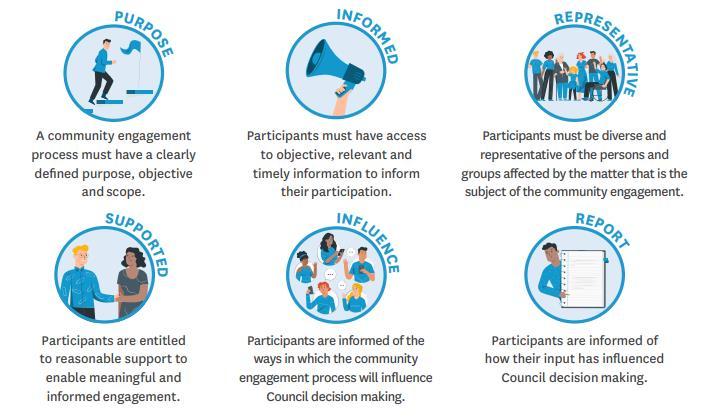
The Framework demonstrates Frankston City Council’s commitment to:
developing a consistent and coordinated approach to community engagement
increase participation and involvement in Council decisions and projects
improve awareness of community engagement as central to Council decision making
In 2020 residents were invited to be part of a Community Panel. A physical invitation delivered to every household in the municipality, asking for expressions of interest.
One hundred and eighty people responded and nominated to be part of our Community Panel, and Council engaged with this group on a range of consultations and forums.
A smaller panel of 46 members was formed from the larger panel. This smaller panel of local residents ranging in age, gender, local area and background was selected independently using specific methodology to ensure it accurately represented the diversity of our community.
The targeted panel met in facilitated workshops to undertake deliberative engagement on the Community Vision and Council Plan.
The panel met on six occasions between November 2020 and February 2021 to discuss and agree themes and priorities used to form the Community Vision Frankston City 2040.
The Vision and suggested priorities were presented to Councillors, to help shape their decision-making process through the 2021–2025 strategic planning cycleconsidering the Council Plan, Financial Plan, Budget and Long Term Infrastructure Plan. Each theme in the Community Vision is represented as an Outcome in the Council Plan.
Frankston City Community Vision 2040
Healthy Families and Communities
Vibrant and inclusive communities
2021-2025 Council Plan and Budget
Healthy and safe communities
Community strength
Natural Environment and Climate Action Sustainable environment
Connected Places and Spaces Well planned and liveable city
Industry, Employment and Education Thriving economy
Advocacy, Governance and Innovation Progressive and engaged city
The Local Government Act 2020 requires that Council develop or review the Financial Plan in accordance with its deliberative engagement practices.
In June 2021, the Community Panel was reconvened to provide direction on community priorities to feed in to the Financial Plan. The objectives of the engagement were:
Service priorities
Seeking advice on how to engage in the future
Council’s role in specific areas
When asked for opinions on how the wider community should be engaged the responses below were provided:
More awareness of future financial initiatives
Annual community surveys
Open communication and clear and unambiguous messaging and seeking periodic feedback
Seeking periodic feedback on how budget is used
Outlining priorities with the community that includes resident businesses and community groups
Engaging through the Community Panel members
Public exhibition of the 2021-2031 Financial Plan for a four week period seeking feedback from the community.
Advocacy
Council aims to reduce the reliance on rate income, therefore Council will advocate to other levels of government for grant funding to support the delivery of important infrastructure and service outcomes for the community. When preparing its financial plan, Council considers its project proposal pipeline, advocacy priorities, upcoming grant program opportunities, and cofunding options to determine what grants to apply for.
Our Advocacy Campaign 2021-2025 underpins a key strategic direction of Council to reduce our reliance on rates and charges revenue and source alternate revenue streams.
Our Draft Advocacy Priorities align to the Council Plan outcomes and are;
Investing in our Prosperity
Enhancing our environment and liveability
Strengthening our community
Strategy statements – Community
1.1 That the community engagement framework is used to inform the development of the financial plan.
1.2 Advocacy priorities are considered in developing the financial plan.
Service Planning Framework
Service Plans and Reviews
Transformation, Continuous improvement, Benefits realisation
Workforce Planning
Service Planning
Service Planning helps Council to make strategic decisions about what services can be delivered based on the current and future needs of the community and the resources available to Council.
Service Plans enable Council a better understanding of our service portfolio and provide opportunity for better informed decision making.
Workforce plans are due to be delivered in 2022 and are strongly integrated with Service Plans.
Service Planning Framework

Council is investing in a Future Ready Frankston program which will focus on automating our processes with customer in mind, build our capability and enhance connectivity.
Benefits realisation of the program are set to deliver planned operational savings across the ten years.
2.1 That the service planning framework is used to inform the development of the financial plan.
2.2 Operational savings target of $0.5 million is set as an efficiency target through implementation of a transformation program.
Asset Management Strategy
Asset Management Framework
Asset Plan
Long Term Infrastructure Plan
Integration to the Asset Plan is a key principle of the Council’s strategic financial planning principles. The purpose of this integration is designed to ensure that future funding is allocated in a manner that supports service delivery in terms of the plans and the effective management of Council’s assets into the future.
The Asset Plan identifies the operational and strategic practices which will ensure that Council manages assets across their life cycle in a financially sustainable manner. The Asset Plan, and associated asset management policies, provide council with a sound base to understand the risk associated with managing its assets for the community’s benefit.
The Asset Plan is designed to inform the Financial Plan by identifying the amount of capital renewal, backlog and maintenance funding that is required over the life of each asset category. The level of funding will incorporate knowledge of asset condition, the risk assessment issues as well as the impact of reviewing and setting intervention and service levels for each asset class.
In addition to identifying the operational and strategic practices that ensure that Council manages assets across their life cycle in a financially sustainable manner, the Asset Plan quantifies the asset portfolio and the financial implications of those practices. Together the Financial Plan and Asset Plan seek to balance projected investment requirements against projected budgets.
Service planning and the setting of service levels enables Council to develop Asset Management Plans and practices that support desired service outcomes. Without Service Plans, Council’s Asset Management Plans can only reliably predict future
funding requirements to safely retain assets in a condition that is compliant with relevant regulatory requirements and fit for use, but not necessarily fit for purpose.
The asset management framework illustrates the relationship between Council’s strategic objectives and asset planning at the strategic, tactical and operational levels.

3.1 That Council seeks to make the right decisions about capital investment and asset management through the Asset Management Framework and alignment to the Integrated Planning and Reporting Framework and Service Planning Framework.
3.2 That Council annually reviews the asset renewal gap and ensures adequate measures are in place to manage it.
3.3 That asset renewal cannot be funded by non-renewable funding sources such as asset sales, reserve funds or loan funds
3.4 That Council seeks to prioritise renewal, compliance and maintenance work
Integrated Planning and Reporting Framework
Review, monitor, report
Governance principles
Other key strategies and plans
Integrated Planning and Reporting Council has developed an integrated, long-term and transparent approach to planning to support Council in strategic decision making.
An Integrated Planning and Reporting framework has been implemented and takes into consideration Councils legislative requirements, including the Governance principles and supporting principles in the Local Government Act 2020:
The community engagement principles
The public transparency principles
The strategic planning principles
The financial management principles
The service performance principles
Key strategies and plans include:
Municipal Planning strategy
Risk Management Plan
Financial Plan
Revenue and Rating Plan
Infrastructure Plan
Asset Plan
Workforce Plan
Health and Wellbeing Plan
Future Ready Frankston (Corporate Strategy)
Master plans
Action Plans
The following diagram demonstrates our Integrated Planning and Reporting Framework. The golden thread approach aims to integrate key strategic plans across Council, along with regular community engagement and performance reporting.
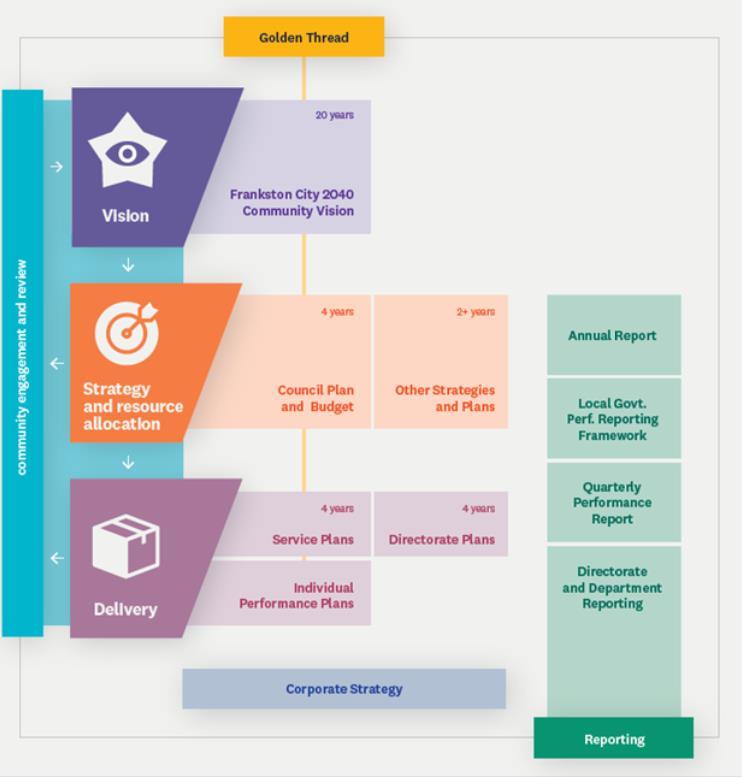
4.1 That Council implements the strategic actions in the adopted 2021-2025 Revenue and Rating Plan
4.2 That Council implements the strategic actions to address strategic risk in the Risk Management Plan
4.3 That Council develops an integrated, longer-term and transparent approach to planning that supports Council in leading strategic decision making.
4.4 That the Financial Plan be developed in accordance with the Governance Principles in the Local Government Act; including the supporting principles.
4.5 That the economic, social and environmental sustainability of the municipal district, including mitigation and planning for climate change risks, is to be promoted
4.5 That Council approves the principle of loan funding as a viable and equitable mechanism of:
• Funding new/significantly upgraded major assets that provide a broad community benefit; or
• Funding capital projects that provide a financial return above annual loan funding costs; or
• Funding of one-off extraordinary operating items in excess of $1 million
4.6 The following financial strategy statements be enacted in the development of the Financial Plan:
• 4.6.1 That reserve funds be drawn down to fund expenditure that is consistent with the purpose of the reserve as noted in the section on reserves strategy.
• 4.6.2 That surplus cash reserves in excess of $0.5 million be transferred to the strategic assets reserve to fund major capital works projects and funding of one-off extraordinary operating items in the future.
• 4.6.3 Proceeds from sale of land are not to be utilised to fund operational expenditure.
• 4.6.4 That Council consider the application of the rate cap as per the Minister Local Government directive
• 4.6.5 That Council considers on an annual basis whether to make application to the Essential Service Commission (ESC) for a variation to
the rate capping framework based on the outcomes contained in the Financial Plan and future infrastructure requirements.
This section presents information regarding the Financial Plan Statements and Statement of Human Resources for the ten years from 2021-2031.
The following financial statements have been prepared in accordance with the Local Government Act 2020 and Local Government (Planning and Reporting).
Financial Statements
o Comprehensive Income Statement
o Balance Sheet
o Statement of Changes in Equity
o Statement of Cash Flows
o Statement of Capital Works
o Statement of Human Resources
Borrowing Requirements
Reserves
2026
2027
2028
2029
Note: The actual 2020-21 FTE numbers contain details of staff that were employed by Council as of 30 June 2021 and excludes vacant positions that are currently either being filled by contract agency staff or in the process of being recruited. Please refer to the Appendix on the detailed movement in FTE numbers between 30 June 2021 and budgeted 2021-22.
The following table highlights Council’s projected loan balance, including new loans and loan repayments for the 10 years of the Financial Plan.
The table below discloses the balance and annual movement for each reserve over the 10-year life of the Financial Plan.
Victorian local government councils have traditionally operated with reserve funds that are amounts of money set aside for specific purposes in later years. In general, these funds do not have bank accounts of their own but are a theoretical split up of the cash surplus that Council has on hand. The following section provides a description of what reserve funds Council holds and their purpose.
The current reserve funds utilised by Frankston City Council and the purpose of each reserve are:
Public resort and recreation reserve
The public resort and recreation reserve is established to hold funds contributed by developers for works associated with developing improved open space and recreational facilities within Frankston City Council. Funds are contributed in accordance with Section 18 of the Subdivision Act and transfers are restricted to the purpose of creating open space such as parks, playgrounds, pavilions and other such items where it is deemed that these works should occur at a later point than the initial development. Separate locations have been established to record revenues received from developers that are to be applied specifically to undertaking future capital works within these locations.
Inflows are solely composed of contributions from subdividers in lieu of the 5 per cent Public Open Space requirement. In terms of outflows, Council considers the following position in terms of utilising these funds as stated below:
“That Council maintain an annual balance of $0.3 million in the Public Resort and Recreation Reserve and utilise the remaining funds in delivering capital works in accordance with the Reserve purpose.”
Council has a large amount of undeveloped open space and this Financial Plan has been based on the principle that these funds in this reserve should be utilised for the combined purposes of developing this land for passive recreation and for significant upgrade works within structured recreation.
The current financial statements do not include the full expenditure of this reserve fund to the extent noted above. Further reviews are currently being undertaken to provide an accurate assessment of what work can realistically be undertaken in the financial periods over the life of this Financial Plan.
Native vegetation reserve
The purpose of this reserve is to enable Council under the native vegetation framework to demonstrate that where there has been a loss of remnant vegetation it has been off set in a location that is sustainable and can be protected into the future. The income and expenditure will occur over different years.
Typical sources of inflows and outflows:
Inflows will be typically from developments where due to site constraints the remnant vegetation cannot be protected on site and the state requires these to be offset and maintained over a 10 year period.
Outflows from this reserve will be in the form of agreed expenditure over the life of this reserve.
Infrastructure reserve
The purpose of this reserve is to set aside funding for roads and drains in growth areas.
Typical sources of inflows and outflows:
Outflows from this reserve will be in the form of agreed projects for roads and drains.
Unexpended grants reserve
The purpose of this reserve is to quarantine operating Federal and Victorian government funding relating received in prior periods for work to be carried out in future periods.
With the changes in Accounting Standards that came into effect in 2019-20, any unspent grant that is received for a specific purpose is recognised as a liability in the balance sheet and only unspent funding that is not tied to a specific purpose is transferred to the reserve at the end of the year.
Typical sources of inflows and outflows:
Inflows are solely composed of significant grant funds received prior to 2019-20 and restricted for specific projects or expenditure in future periods.
Outflows from this reserve will be transfers back to operations or specific projects as per unexpended grant listing.
Capital projects
The capital projects reserve has been established by Council and represents funding allocated to capital projects that have not been delivered in a prior year.
Typical sources of inflows and outflows:
Inflows are solely composed of funding allocated to capital projects that have not been delivered in a prior year as the delivery is either delayed or project is not going ahead.
Outflows from this reserve will be transfers back to specific projects as per long term infrastructure plan.
Strategic assets
The strategic projects reserve has been established by Council with the proceeds to fund works considered by Council to be of a strategic nature.
Typical sources of inflows and outflows:
Inflow to this reserve will typically be from the sale of Council land and when Council achieves a surplus outcome at the conclusion of financial years and resolves to transfer surplus funds into this reserve.
The development of a new Council Plan for 2021-2025 has set 20 strategic priorities for the next four years that will require careful financial planning to see Frankston City reach a vision as the lifestyle capital of Victoria. In order to deliver community infrastructure such as a revitalised City, regional sporting facilities, further development of the Frankston Stations Precinct and re-development of the existing Frankston Arts Centre, a financially sustainable Council must exist. Each of these projects in themselves is extremely significant and involves expenditure in the tens of millions. At the same point, Council must maintain its existing assets and meet the asset renewal challenges, continue to provide a strong suite of operational services to its residents and provide for the ongoing capital development of Council across a broad range of items in addition to the major priorities mentioned above.
In the future, outflows are anticipated to be for the funding of major capital works projects or where Council is required to source major funding where there is no option but to utilise cash reserves.
Resource efficiency
The purpose of this reserve is to provide Council with an opportunity to set aside funds and highlight the benefit of energy conservation measures to save money and achieve Council’s greenhouse reduction goals.
Typical sources of inflows and outflows:
Inflows to this reserve are the annual expected savings from energy reduction projects.
Outflows from this reserve will be the reinvestment in future years for further works to minimise energy consumption. Whilst the Financial Plan presently does not show any outflows, this is simply due to uncertainty in respect of when they are likely to arise and it is expected the reserve will be accessed over the life of this plan.
Local Government Funding Vehicle (sinking fund)
The purpose of this reserve is to partly provide for the principal repayments required on maturity of the interest-only Local Government Funding Vehicle (LGFV) and to provide future borrowing capacity for major infrastructure projects.
Typical sources of inflows and outflows:
Inflows will comprise savings derived from annual loan repayments and interest savings compared to the original budget provision of these items. Inflows will also include ‘transfers in’ required to fund debt redemption commitments (interest expense and principal repayments).
PARC asset management
This reserve has been established to provide a source of funding for the portion of the PARC asset management plan that Council is responsible for.
Typical sources of inflows and outflows:
Inflows are composed of funding that is transferred annually from the accumulated surplus to cover the expenditure contained in the PARC asset management plan.
Outflows from this reserve will be transfers back to operations or specific projects as may be determined by Council and PARC.
Other reserves
These reserves have been established to provide a source of funding for car parking and subdivisional works.
Typical sources of inflows and outflows: Inflows are composed of funding for car parking and subdivisional works. Outflows from this reserve will be transfers back to operations or specific projects as may be determined by Council.
We measure our performance against our Financial Policy Statements, the Local Government Performance Reporting Framework (LGPRF) and the Victorian Auditor General Office (VAGO) assessment of financial sustainability indicators.
This section models the key results relating to the Financial Policy statements explained earlier on page 13. These measures demonstrates Council's financial sustainability to fund the aspirations of the Community Vision and the Council Plan. Below are the key measures that we use to ensure that Council is financially sustainable in to the future.
Ensures thatCouncilcould repayits interest commitmentfromthe rate income and growthinthe
ThatCouncils applies loanfunding to newcapitaland maintaintotalborrowing inline withrate income and growthofthe municipality
Councilmaintains sufficientrestricted cashto ensure ongoing liquidityas wellas to address unforeseen cashimposts
Allocate adequate funds towards renewalcapitalin orderto replace assets and infrastructure as they reachthe end oftheirservice life
Guide to risk of not achieving financial sustainability:
Low Risk
Medium Risk
High Risk
* The negative result for the adjusted underlying result relates to the impact caused by Covid-19 and the investment in the Future Ready Frankston Program, where benefits will flow through in later years. The 13.7% adverse result in interest and principal repayments relate to the repayment of the low interest bearing loan of $15 million that Council obtained from the Local Government funding vehicle. Money to pay off this loan has been transferred to a reserve each year, and the debt will be redeemed from the reserve instead of general cash reserves. Detailed explanation of the results of these indicators and other key performance indicators are in the section on Measuring our Performance.
Key to Forecast Trend:
Forecasts improvement in Council's financial performance/financial position indicator
Forecasts that Council's financial performance/financial position indicator will be steady
Forecasts deterioration in Council's financial performance/financial position indicator


This measures Council’s ability to generate a surplus in the ordinary course of business, and excludes external funding received for capital works projects. The negative result in 2020-21 of the plan is due to the financial impact caused by Covid-19 and the investment in the Future Ready Frankston Program, where benefits will flow through in later years. This indicator improves with the cost efficiencies that Council has projected in the future years.
This indicator measures Council’s ability to pay existing liabilities in the next 12 months. Although Council’s working capital ratio is above the target over the next ten years, it trends downwards in the medium term of the Financial Plan due to the additional borrowings of $60.8 million factored in. The indicator improves in the longer term due to repayments of borrowings and the recurrent efficiencies that will be achieved from the Future Ready Frankston Program.
This measures Council’s ability to pay existing liabilities in the next 12 months using cash reserves that are not restricted like trust funds and statutory reserves. Basically it assesses the ability that Council has to pay its bills on time without utilising cash that are held to fund specific activities. Other Financial assets which include term deposits over 90 days are not considered as unrestricted cash in this indicator. Again although, the ratio is above the target over ten years, it is trending downwards in the medium term and improves in the longer term similar to the working capital ratio.
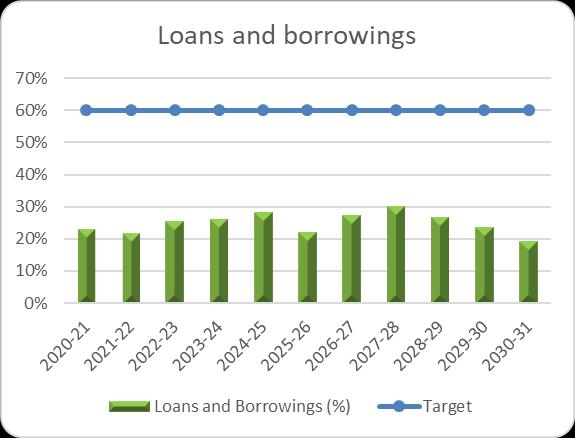
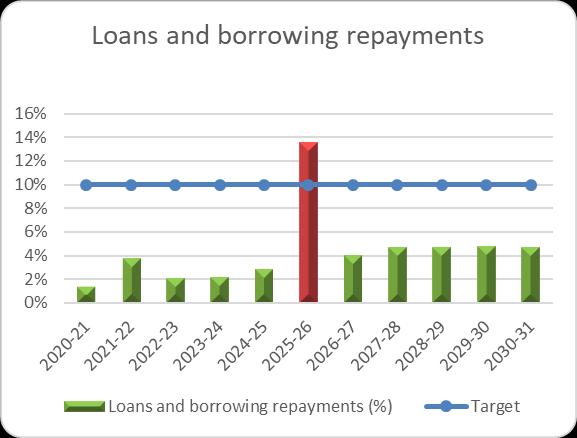
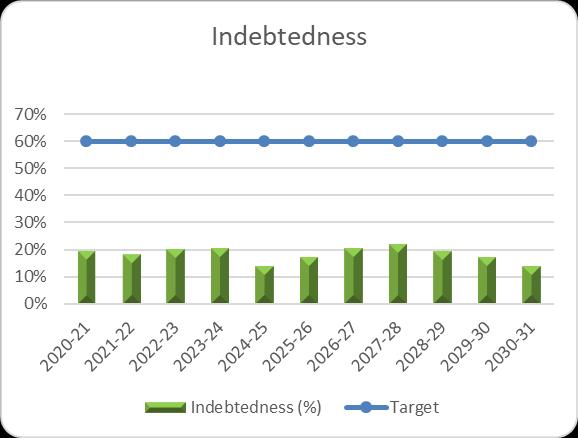
This measures Council’s ability to pay its interest bearing loan obligations with the rate revenue it generates. Council is well below the target KPI of 60 per cent for this indicator and has the ability to borrow to fund major capital works projects in the future.
This measures Council’s ability to pay its debt obligations with the rate revenue it generates. Council is well below the target KPI of 10 per cent for this indicator (except in 2025-26) which means that Councils can pay its loan repayments and interest from rates instead of looking at alternative funding streams.
The one off expenditure in 2025-26 is the repayment of the low interest bearing loan of $15 million that Council obtained from the Local Government funding vehicle. Money to pay off this loan has been transferred to a reserve each year, and the debt will be redeemed from the reserve instead of general cash reserves. Please refer to the Reserves Strategy section for more information.
This measures Council’s ability to pay its long term obligations with the revenue it generates internally (i.e. excludes external grants and contributions). Council is well below the target KPI of 60 per cent and the level of long term obligations can easily be met without relying on external funding sources to repay its debt commitments.

This measures the renewal and upgrade expenditure that Council incurs on its existing asset base compared to depreciation expense. This assesses whether Council’s assets are being renewed or upgraded as planned and compares the rate of spending on existing assets through renewing, restoring, replacing or upgrading existing assets with depreciation expense.
A measure above 100 per cent indicates that there is less risk of insufficient spending on Council’s existing asset base. Council’s spending on renewal is based on its asset renewal and asset management strategy. Council maintains a healthy ratio in most of the years with the measure dipping slightly in a few years of the Financial Plan.
Council has focussed on bringing down its asset renewal backlog with consistent expenditure incurred on renewal over the years. The backlog has been reduced to a manageable level of approximately $8.8 million by the end of 2020 and plans to reduce the gap further over the life of the Financial Plan.
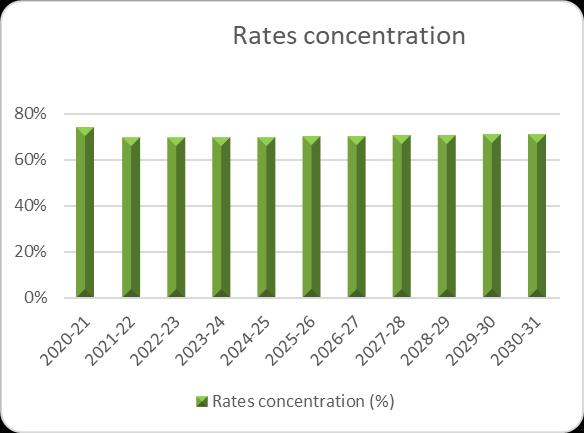
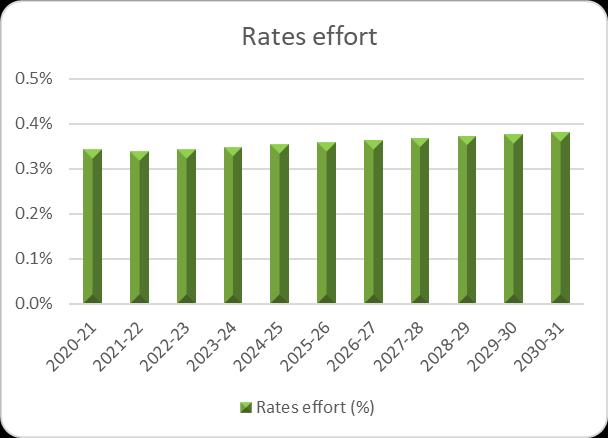
This indicator assesses whether Council can generate revenue from a range of sources, excluding grants and contributions received for capital works to fund services and activities. A low percentage indicates that Council is not entirely reliant on rate income to fund services. This indicator is fairly stable over the ten years averaging around 70 per cent which is not too dissimilar to other metropolitan Councils providing similar services and receiving lower grant funding from State and Federal Governments.
This indicator assesses whether Councils set rates at an appropriate level. A lower ratio indicates a reduced burden to the community. This indicator is fairly stable over the life of the Financial Plan with Council estimating that future rate caps will be limited to 2 per cent and that Council will deliver existing services by meeting the rate cap.
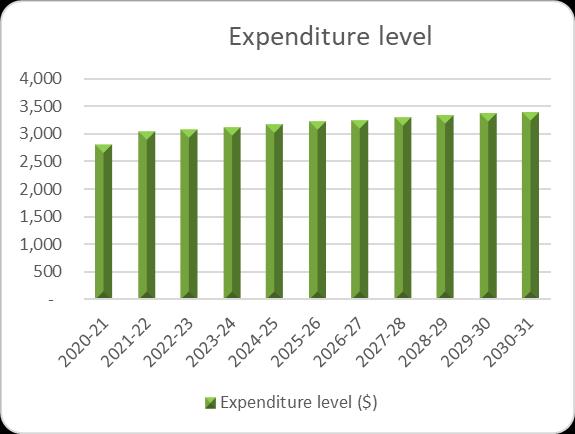
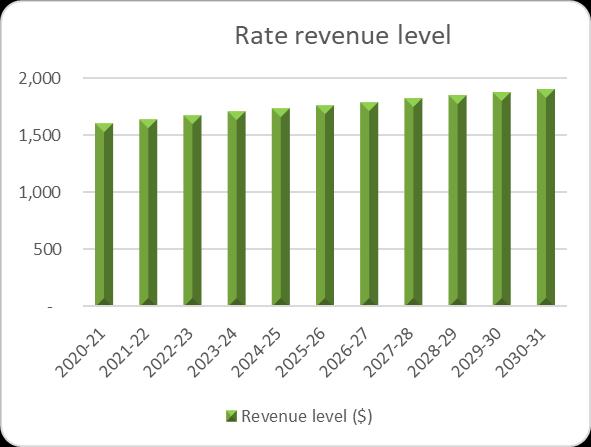
This indicator assesses whether resources are being used efficiently to deliver services. Council’s performance of this indicator over the ten years is fairly static. Council is committed to targeting service delivery based on the needs of the community and is confident that the Future Ready Frankston program and the newly developed service delivery methodology will bring in more efficiencies in the future.
This indicator assesses whether resources are being used efficiently to deliver services. Council’s estimated rate revenue increase is tied to the rate cap which is estimated at 2 per cent over the life of the plan. Council is committed to keeping rates as low as possible whilst continuing to deliver high quality services that are valued by the community.
Guide to risk of not achieving financial sustainability:
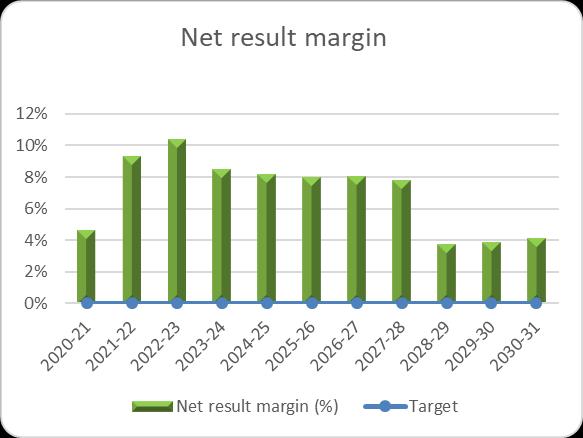
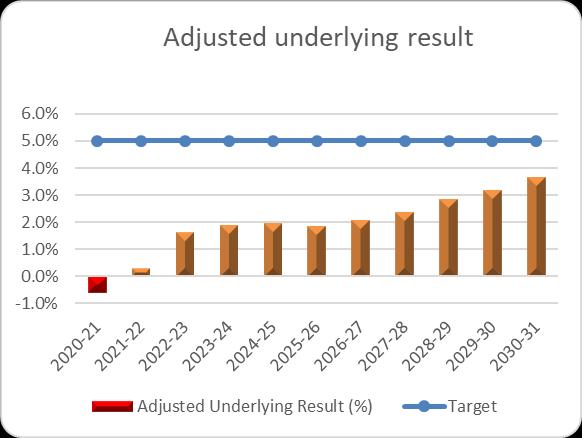

This is a basic measure that a positive result indicates a surplus, and the larger the percentage the stronger the result. A negative result indicates that insufficient revenue is generated to fund operations and asset renewal. Council has budgeted to have surpluses in all ten years of the Financial Plan and is well above the 0 per cent that VAGO uses as a low risk assessment.
This measures Council’s ability to generate a surplus in the ordinary course of business and similar to the LGPRF indicator on adjusted underlying surplus, excludes non-recurrent capital grants, nonmonetary asset contributions, and other contributions to fund capital expenditure from the netresult.
Council isof theopinion thattheresultof5percent that VAGO uses as an indication of a low risk assessment is too high. In a rate capping environment, where Council does not have much control over rate increases and is committed to keeping fees for Council controlled events and services as low as possible to reduce burden to the community whilst, continuing to deliver existing services. . The negative result in2020-21 of the plan is due to the financial impact of Covid-19 and the investment in the Future Ready Frankston Program, where benefits will flow through in later years. This indicator improves with the cost efficiencies that Council hasprojectedinthefutureyears.
This indicator measures Council’s ability to pay existing liabilities in the next 12 months. A ratio greater than one means that there are more cash and liquid assets than short-term liabilities. Although Council’s liquidity ratio is above the target over the next ten years, , it trends downwards in the medium term of the Financial Plan due to the additional borrowings of $60.8 million factored in. The indicator improves in the longer term due to repayments of borrowings and the recurrent efficiencies that will be achieved from the Future Ready Frankston Program.
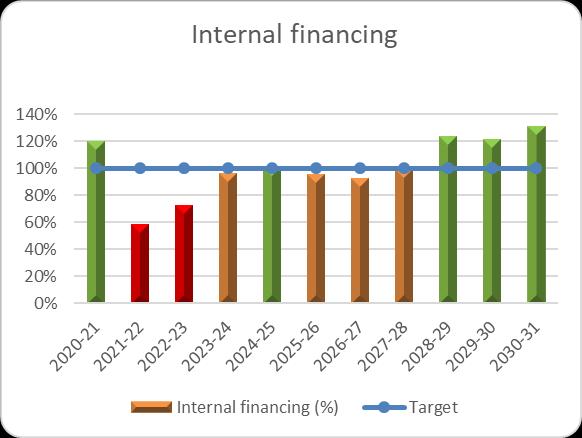

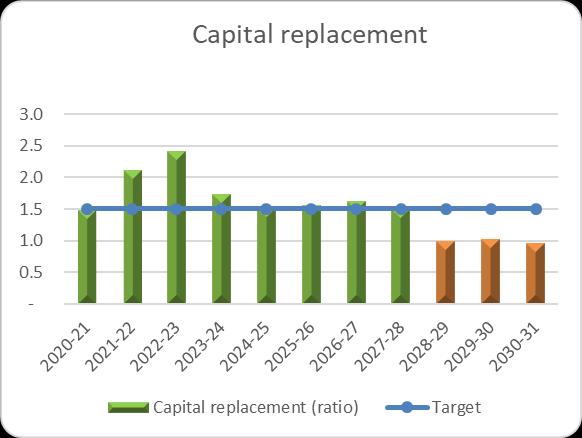
This measures the ability of Council to finance capital works from generated cash flow. The higher the percentage the greater the ability for Council to finance capital works from their funds. Council’s performance on this indicator is below the target set by VAGO of 100 per cent in some of the years, as Council uses borrowings as a source of funding to fund major capital works projects.
Council’s borrowings are at healthy levels and has capacity to borrow more.
Council will continue to advocate to the State and Federal Governments to fund some of the major projects that borrowings have been factored into as a funding source so that Council does not need to borrow to deliver these projects.
This measures a Council’s ability to pay the principle and interest of borrowings and other long term debt commitments, as and when they fall due, from the funds it generates. The lower the ratio the less revenue that Council is required to use to repay its long term obligations. This indicator is calculated the same as the LGPRF indebtedness indicator and Council’s performance is at healthy levels throughout the life of the Financial Plan.
This measure compares the rate of spending on new infrastructure, property, plant and equipment with depreciation. Ratios higher than 1 indicates that spending is faster than the depreciation rate.
Council’s spending on capital works is in line with projected depreciation with the indicator dipping slightly in the final three years of the Financial Plan.
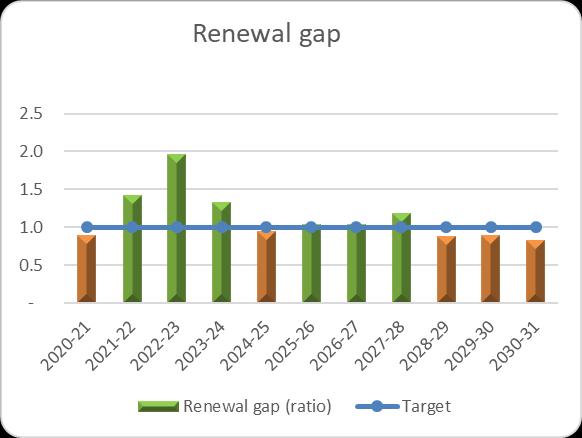
This compares the rate of spending on existing assets through renewing, restoring, and replacing existing assets with depreciation. Council maintains a healthy ratio in most of the years with the measure dipping slightly in a few years of the Financial Plan.
This section presents information regarding the assumptions to the Comprehensive Income Statement for the 10 years from 2021-22 to 2030-31. The assumptions comprise the annual escalations / movement for each line item of the Comprehensive Income Statement.
Following each statement are notes of the assumptions specifically applied to produce the long-term outlook. The notes are referenced in the financial statements. A commentary is also provided on the information relayed by the statements and what they mean for Frankston City Council.
In a more global sense however, it is worthwhile detailing the approach to the modelling process as broad percentages have not been universally applied. Certain accounts were coded for manual adjustment rather than broad percentage increases (e.g. non recurrent grant income, contributions and election income). It is therefore not possible to simply multiply the previous year’s base by a percentage and achieve the same outcomes as presented.
The table below highlights the broader parameters used in the calculation of this Financial Plan. These parameters are discussed in more detail below:
Base rate revenue will increase by 1.5 per cent for the 2021-22 year, based on the state government rate cap, and with estimated annual increase of 1.75 per cent based on State Government estimate of CPI for 2022-23 and 2 per cent per annum for the ensuing years thereafter of the Financial Plan. In addition, it is expected that over the life of the plan, a further increase of 1 per cent per annum will be received for growth (additional properties) as a result of supplementary rates.
Council’s general waste charges have increased by 5.6 per cent compared to 2020-21, due to the increased service cost resulting from the pressures impacting the recycling industry. The industry continues to be challenged by the contamination standards required by the international markets using recycled products. Recycling processors have progressed with installing infrastructure with funding from the increased recycling charges to lower the contamination and improve the quality of recycled products for reuse.
Council has allowed for a blanket hard waste collection for the term of the Financial Plan and will retain an “at call” service for the convenience of residents and ratepayers. The Frankston Regional Resource and Recycling Centre provides residents with an “all year round” facility for the disposal of hard and other waste.
The costs of green waste services have not increased compared to 2020-21. Future years’ waste charges are estimated to increase in line with cost escalations of 2.5 per cent to ensure Council continues to recover the full costs of providing waste services.
For further information please refer to Council’s adopted 2021-2025 Revenue and Rating Plan.
Statutory fees and fines
Victorian Government statutory fees are set by legislation and are frequently not indexed on an annual basis. An estimated increase of 2.00 per cent has been allowed for statutory fee income.
Council has reviewed fees in detail to determine accepted pricing principles and set levels that fully recover the cost of providing the service, unless the overriding policy is in favour of subsidisation. In addition, considerations of community factors are required such as encouraging use of a service and ability to pay. Therefore fees have been adjusted based on this methodology rather than a blanket increase.
Council will continue to seek opportunities to maximise revenue from fees and charges through a thorough review across the organisation to ensure that ‘Best Value’ principles including service cost and quality standards, value for money are balanced with the affordability and accessibility of these services.
Council currently receives grants for tied (specific purpose grants) and un-tied Financial Assistance grant funding received via the Victorian Local Government Grants Commission (VLGGC). Operational Grants and subsidies have been budgeted with a conservative economic outlook at 1 per cent. This low increase in grant revenue is to manage cost-shifting that is likely to occur on an annual basis with grants seldom increasing at an equivalent rate to the cost of providing the subsidised services.
Capital grants have been forecast in conjunction with the estimates provided on specific capital projects. Currently there is only one type of capital grant that Council is able to forecast with some certainty over the life of the Financial Plan. That grant is from the Commonwealth Government under the Roads to Recovery Program towards local roads. The current Roads to Recovery Program commenced on 1 July 2019 and ends on 30 June 2024. Certain conditions must be followed and annual reports must be submitted. It is assumed that the program will continue over the life of the Financial Plan.
Council receives monetary contributions mainly from developers. These contributions represent funds to enable council to provide the necessary infrastructure and infrastructure improvements to accommodate
development growth. The contributions are for specific purposes and often require Council to outlay funds for infrastructure works often before receipt of this income source. Contributions received from developers are statutory contributions and are transferred to a restricted reserve until utilised for a specific purpose through the capital works program or delivered as works in kind by developers. Council also receives minor contributions from various sporting clubs towards various projects in the capital works program.
Interest on investments comprises of interest earned from cash invested with financial institutions, interest charge to ratepayers for rates in arrears and interest received on special charge income.
Also included under this heading is income received from recoveries of infringements (formerly Perin Court) costs (relating to parking infringements) and recoveries from State Revenue Office of valuation costs.
Enterprise Bargaining Agreement No.9 (EBA9) will expire on 1 July 2023. This Financial Plan has been developed based on subsequent increases being linked to the rate cap and a further 0.50 per cent to account for banding increments. Superannuation guarantee charge increases were announced as part of the 2014 Federal Budget and this Financial Plan assumes that superannuation will increase progressively from 9.5 per cent in 2019-2020 to 12.0 per cent by 2025-26.
The cost of provision of Council services is very heavily based on labour costs which account for approximately 45 per cent of total operational spending.
Material costs include items required for the maintenance and repairs of Council buildings, roads, drains and footpaths which are more governed by market forces based on availability than CPI. Other associated costs included under this category are utilities, materials for the supply of meals on wheels and consumable items for a range of services.
Council also utilises external expertise on a range of matters, including legal services and audit.
Council has significant ongoing contracts for delivery of services such as waste management and maintenance of parks and gardens. Council also engages contractors for building maintenance and general valuations. All these contracts are negotiated at near CPI levels as far as possible.
General materials and services excluding utility costs are expected to increase by 2 per cent in line with CPI.
Outside of the broad parameters, there have been a number of manually assessed items in this area, including election expenses, valuation contract amounts, insurance costs and waste costs.
Electricity and Gas market expectations indicate a stable increase of 5 per cent over the term of the Financial Plan. These costs will be closely monitored. Water costs have stabilised compared to previous years and have been estimated to increase by 5.00 per cent over the term of this Financial Plan. These costs will be closely monitored.
Bad and doubtful debts are expected to increase marginally over the life of the Financial Plan and primarily relates to parking fines forwarded to the Infringement Court (formerly Perin Court) for collection and a consequent reduction in collection rates. Council has improved its debt management processes to ensure that collection is timely.
Depreciation estimates have been based on the projected capital spending contained within this Financial Plan and projected depreciation of existing assets.
Borrowing costs comprise the interest expense to service Council's loan portfolio. Details on borrowings are covered in greater detail on the section on Borrowing Strategy.
Other expenses include administration costs such as Councillor allowances, election costs, sponsorships, partnerships, community grants, lease expenditure, fire services property levy, audit costs and other costs associated with the day to day running of Council.
Council is required to follow the prescribed formatting of Local Government Victoria’s model financial plan, which compares the forecast position of the current financial year (Actual 2020-21) to the budget.
The actual FTEs include only information of staff that were employed by Council as at 30 June 2021 and excludes vacant positions. The budget has been set based on a full establishment, which includes vacant positions. The budget also excludes temporary work arrangements of staff where they salary sacrifice for additional leave.
The following table explains the reasons for the difference in staff FTEs between actual numbers and the budget.
Act Local Government Act 2020
Accounting Standards
Australian accounting standards are set by the Australian Accounting Standards Board (AASB) and have the force of law for Corporations law entities under S 296 of the Corporations Act 2001. They must also be applied to all other general purpose financial reports of reporting entities in the public and private sectors.
Advocacy Work done by Council on behalf of community to access and secure government funding – State and Federal – to deliver infrastructure, facilities and services that are beyond Council’s responsibility to fund.
Annual report Report prepared by Council under sections 98-100 of the Act. The annual report to the community contains a report of operations and audited financial and performance statements.
Asset expansion expenditure Expenditure that extends the capacity of an existing asset to provide benefits to new users at the same standard as is provided to beneficiaries.
Asset renewal expenditure Expenditure on an existing asset or on replacing and existing asset that returns the service capability of the asset to its original capability.
Asset upgrade expenditure Expenditure that:
(a) enhances an existing asset to provide a higher level of service; or
(b) Increases the life of the asset beyond its original life.
Balance sheet Shows the expected net current asset, net non-current asset and net asset positions in the forthcoming year compared to the forecast actual in the current year. The balance sheet should be prepared in accordance with the requirements of AASB101 Presentation of Financial Statements and the Local Government Model Financial Report.
Borrowing strategy The process by which the Council's current external funding requirements can be identified, managed and future requirements monitored.
Budget Plan under Section 94 of the Act setting out the services and initiatives to be funded for the financial year and how they will contribute to achieving the strategic objectives specified in the Council Plan.
Business Continuity Plans Outlines procedures and instructions Council must follow in the face of disaster, whether fire, flood or cyberattack, so Council can continue to function with as little disruption as possible.
Capital expenditure Capital expenditure is relatively large (material) expenditure that produces economic benefits expected to last for more than 12 months. A pre-determined 'threshold' may be used which indicates the level of expenditure deemed to be material in accordance with Council's policy. Capital expenditure includes renewal, expansion and upgrade. Where capital projects involve a combination of renewal, expansion and upgrade expenditures, the total project cost needs to be allocated accordingly.
Capital Improved Value (CIV)
Capital works program
Carry forward capital works
Community Engagement
The value of the land plus buildings on it and any other substantial improvements made to the property.
Regulation 10 requires that the budget contains a detailed list of capital works expenditure and sets out how that information is to be disclosed by reference to asset categories, asset expenditure type and funding sources.
Carry forward capital works are those that are incomplete in the current budget year and will be completed in the following budget year.
Seeking feedback from the local community on decisions that interests and / or impacts them
Comprehensive income statement
Council Plan
Deliberative Community Engagement
Discretionary reserves
Enterprise Bargaining Agreement
Shows the expected operating result in the forthcoming years and should be prepared in accordance with the requirements of AASB101 Presentation of Financial Statements and the Local Government Model Financial Report.
A plan setting out the medium-term strategic objectives, strategies, strategic indicators and aspirations of the community in the next four years and prepared in accordance with Section 90 of the Act.
An approach which encourages community members to critically test, weigh up and consider a range of information, perspectives, inputs and evidence to reach a consensus or make recommendations to Council.
Discretionary reserves are funds earmarked by Council for various purposes.
A form of collective bargaining, in which wages and working conditions are negotiated between Council and the employee trade union acting on behalf of employees. Once established, they are legally binding on employers and employees that are covered by the Enterprise bargaining agreement.
External influences in the preparation of a budget
Financial risk
Financial Statements
Matters arising from third party actions over which Council has little or no control e.g. Change in legislation.
Potential for finance loss from transactions and uncertainty about its extent
Sections 91 of the Act and Section 5 of the Local Government (Planning and Reporting) Regulations 2020, require the following statements to be included in the Financial Plan. These statements are jointly referred to as financial statements
- Comprehensive Income Statement
- Balance Sheet
- Statement of Changes in Equity
- Statement of Cash Flows
- Statement of Capital Works
Financial sustainability
Financing activities
Internal influences in the preparation of the budget
Investing activities
The financial statements must be in the form set out in the Local Government Model Financial Plan.
Ability to serve community by achieving Council’s vision and strategic objectives and maintain resources over time.
Those activities which relate to changing the size and composition of the financial structure of the entity, including equity and borrowings not falling within the definition of cash.
Matters arising from Council actions over which there is some element of control (e.g. approval of unbudgeted capital expenditure).
Those activities which relate to acquisition and disposal of noncurrent assets, including property, plant and equipment and other productive assets, and investments not falling within the definition of cash.
Key assumptions
Legislative framework
Local Government (Planning and Reporting)
Regulations 2020
When preparing a balance sheet of financial position, key assumptions upon which the statement has been based should be disclosed in the budget to assist the reader when comparing movements in assets, liabilities and equity between budget years.
The Act, Regulations and other laws and statutes which set a Council's governance, planning and reporting requirements.
Regulations, made under S.325 of the Local Government Act 2020. prescribe:
(a) The content and preparation of the financial statements of a Council
(b) the performance indicators and measures to be included in the budget, revised budget and annual report of a Council
(c) The information to be included in a Financial Plan, budget, revised budget and annual report
(d) Other matters required to be prescribed under Part 4 of the Act.
Local Government Performance
Reporting Framework (LGPRF)
Local Government Community Satisfaction survey
This is a mandatory system of performance reporting for all Victorian councils. It ensures that councils are measuring and reporting on their performance in a consistent way to promote transparency and accountability in the local government sector.
The framework is made up of a range of measures, including roads, planning, animal management and waste. It is complemented by a Governance and Management checklist of 24 items, which shows the policies, plans and procedures in place at each council. Together, they build a comprehensive picture of council performance which can be viewed on the Know Your Council website.
This is a state-wide telephone survey which collects direct feedback from the community about councils.
It covers:
•council's overall performance
•community consultation and engagement
•customer service
•overall council direction
The survey is conducted by the Department of Jobs, Precincts and Regions on behalf of participating councils. A minimum of 400 local residents and ratepayers in each municipality over 18 years of age are selected at random.
Local Government Model Financial Report
Long Term Infrastructure Plan
New asset expenditure
Non-financial resources
Local Government Model Financial Report published by Local Government Victoria which Councils are required to follow in preparing their financial statements.
A report covering a detailed list of capital works expenditure planned to be delivered over 10 years. This is not a mandatory requirement, but, Council publishes this information along with the Financial Plan.
Expenditure that creates a new asset that provides a service that does not currently exist.
Means the resources other than financial resources required to deliver the services and initiatives in the budget.
Non-recurrent grants
Operating activities
Operating expenditure
Means a grant obtained on the condition that it be expended in a specified manner and is not expected to be received again during the period covered by a Council's Strategic Resource Plan.
Operating activities means those activities that relate to the provision of goods and services.
Operating expenditure is defined as consumptions or losses of future economic benefits, in the form of reductions in assets or increases in liabilities; and that result in a decrease in equity during the reporting period.
Operating performance
Operating revenue
Own-source revenue
Rating strategy
This statement shows the expected operating result as compared to the budget result in the current year separating operating and capital components of revenue and expenditure.
Operating revenue is defined as inflows or other enhancements or savings in outflows of future economic benefits in the form of increases in assets or reductions in liabilities and that result in an increase in equity during the reporting period.
Revenue that Council generates internally and excludes external sources of income like Government grants and contributions.
A rating strategy is the process by which the Council's rate structure is established and how the total income generated through rates and charges is allocated across properties in the municipality. Decisions regarding the quantum or rate levels and increases from year to year are made as part of Council's long term financial planning processes and with consideration of Council's other sources of income and the planned expenditure on services and works to be undertaken for its community.
Recurrent grant
A grant from Government that is expected to be received on a continuing basis
Regulations Local Government (Planning and Reporting) Regulations 2020
Restricted cash Cash and cash equivalents, within the meaning of Australian Accounting Standards, that are not available for use other than a purpose for which it is restricted, and includes cash to be used to fund capital works expenditure from the previous financial year and trust funds and bonds that are held.
Revenue and Rating Plan
A Plan that determines the most appropriate and affordable revenue and rating approach for Council which in conjunction with other income sources will adequately finance the objectives in the council plan.
Strategies outlined in this plan align with the objectives contained in the Council Plan and feed into the budget and the Financial Plan, as well as other strategic planning documents under Council’s strategic planning framework.
Statement of capital works
Statement of cash flows
The statement of capital works shows the expected internal and external funding for capital works expenditure and the total proposed capital works expenditure for the forthcoming years. The statement of capital works should be prepared in accordance with the Local Government (Planning and Reporting) Regulations 2020 and the Local Government Model Financial Plan.
The statement of cash flows shows the expected net cash inflows and outflows in the forthcoming year in the form of a reconciliation between the opening and closing balances of total cash and investments for the year. The cash flow statement should be prepared in accordance with the requirements of AASB 107 Statement of Cash Flows and the Local Government Model Financial Report.
Statement of changes in equity
Statement of Human Resources
Statutory reserves
The statement of changes in equity shows the expected movement in accumulated surplus and reserves for the years. The statement of changes in equity should be prepared in accordance with the requirements of AASB 101 Presentation of Financial Statements and the Local Government Model Financial Report.
A statement which shows all Council staff expenditure and the number of full time equivalent Council staff.
Statutory reserves are funds set aside for specified statutory purposes in accordance with various legislative requirements. These reserves are not available for other purposes.
Strategic risk Risks that arise from fundamental decisions that Council takes on long term objectives
Unrestricted cash
All cash and cash equivalents other than restricted cash.
Workforce plans A plan developed and maintained by the Chief Executive Officer of a Council under section 46(4)(a) of the Act that:
(i) describes the organisational structure of the Council;
(ii) specifies the projected staffing requirements for a period of at least 4 years; and
(iii) sets out measures to seek to ensure gender equality, diversity and inclusiveness.

Our cover displays street art that was created for The Big Picture Fest Frankston 2020. For more information or to take a street art walking tour of Frankston please visit thebigpicturefest.com.au
This art can be found at Stiebel Place, Frankston.
Artist PichiAvo (Juan Antonio Sánchez Santos and Álvaro Hernández Santaeulalia)
@pichiavo
PichiAvo is Juan Antonio Sánchez Santos (Pichi, b. 1977) and Álvaro Hernández Santaeulalia (Avo, b.1985), a duo of street artists from Valencia (Spain).
Recognised for their skill at creating connections between painting and sculpture in urban settings, they adopt a thoroughly innovative approach in their artistic fusions. A balanced combination of classical art and the most contemporary urban art can be identified in their work. From the outset PichiAvo shunned artistic individuality, joining forces to create an absolutely unique body of work using a conceptually urban idiom, both in the street and in the studio.
They trained in Fine Art and in Design and met on the graffiti art scene in Valencia, forming the PichiAvo duo in 2007. From that moment they worked on developing joint projects, pursuing an unremitting search for a style of their own. To achieve this they went through various stages as painters, focusing initially on skill and technique until they reached the point of needing to express themselves through what most defines them today: graffiti and classical art. They work both outside and inside the studio, in painting, sculpture and installation, embracing a wide and versatile range of material and painterly approaches.
In 2015 PichiAvo produced their first large mural in the North West Walls Festival in Belgium, having been invited by fellow artist Arne Quinze. This work launched their international career. From then on,
they have carried out projects at some of the leading venues in international urban art, such as Wynwood Walls (2015) and the Hard Rock Stadium (2016), both in Miami, and the Houston Bowery Wall in New York (2017), where theirs was the first painting intervention by European artists. In 2019 they created a monumental 26m high sculpture for the Fallas Festival in Valencia and held their first major exhibition in a public art centre. In April 2019 they executed the second largest mural in the world in the city of Porto, in collaboration with the celebrated Portuguese artist Vhils.
PichiAvo’s career has attained artistic recognition and popularity on an international scale, establishing them among the most prominent street artists on the current urban art scene.
Photography by Steve BrownHow to contact us
Online: frankston.vic.gov.au
In person: 30 Davey Street
Frankston VIC 3199
Australia
Telephone: 1300 322 322
+61 3 9784 1094
Business hours, Monday to Friday (Public holidays excluded)
Fax:
+61 3 9784 1094
In writing:
Frankston City Council PO Box 490
Frankston VIC 3199

Interpreter services
We cater for people of all backgrounds
Please call 131 450
National Relay Service
If you are deaf, hard of hearing and/or have a speech impairment you can contact the Council using the National Relay Service.
Teletypewriter (TTY) 133 677
Voice Relay 1300 555 727
SMS Relay 0423 677 767